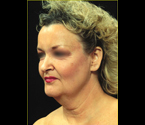Mini Facelift in Chicago


* Individual results may vary.
Photo Gallery
View before-and-after pictures of real patients of Dr. Laurie A. Casas
Turning back the signs of aging in the face and neck can range from using nonsurgical options to electing a mini facelift (rhytidectomy), a full or complete facelift, and a neck lift. Facial aging is accelerated by gravity, excessive sun exposure, and smoking. The signs are seen on the surface of the face and neck skin as wrinkles and in the deeper layers of the face and neck as soft tissue loss that intensifies skin sagging.
During the initial consultation, Dr. Casas may ask you to point out exactly what you would like to see improved. Dr. Casas may discuss with you additional surgical and nonsurgical procedures that can be performed to improve your result.
What is a Mini Facelift?
A mini facelift is a minimally invasive facelift that corrects early signs of aging. It is a less-intense version of a traditional facelift that requires fewer incisions, but it focuses on the lower third of the face, and in some cases, the neck. A mini facelift does not address the upper or mid face.
How is a Mini Facelift Performed?
A mini facelift uses shorter and fewer incisions than a full or traditional facelift. It can be done under general anesthesia but is mostly performed under a combination of local anesthesia with or without sedation.
At Casas Aesthetic Plastic Surgery, a mini facelift is frequently performed in the office setting under light sedation. Dr. Laurie Casas will help you better understand if you are a candidate for this minimal scar facelift surgery. Weeks prior to surgery, Dr. Casas will prepare your skin for surgery with skin care products incorporating retin-A and oftentimes Botox®, fillers, and soft tissue volumetric agents.
During the procedure, Dr. Casas makes tiny incisions under and around the ear. The incisions do not extend to the hairline along the temples or behind the ear.
Dr. Casas performs less extensive dissections of the tissue and muscles under the skin. Then, the skin and the soft tissue layers are separated from the deeper muscle layer. This allows for small to moderate tightening of relaxed muscles of the face, jawline, and upper neck while the skin is pulled and tightened. Afterward, the excess skin and fat tissue are trimmed away.
Finally, Dr. Casas closes the cuts with stitches and sutures. This is done delicately and neatly to minimize scarring after your procedure. The results are a smoother face, a more defined jawline and neck, and a radiant, youthful look.
A mini facelift usually takes 1-2 hours, and the scars are usually concealed inside the ear structures and sometimes in the crease behind the ear. This may, however, vary depending on the technique your surgeon uses and your desired results. The goal of the face and neck tightening is to look “fresh,” not pulled and too tight. There are many techniques which Dr. Casas will discuss with you so that your face and neck lift are customized to meet your expectations.
After surgery, Dr. Casas will place protective bandages around your head. These bandages will be removed two or three days after surgery. Each patient recovers at a different pace, and Dr. Casas will instruct you to take supplements before and after surgery that will help to decrease the swelling and bruising. Massage therapy is also used to quicken the recovery process. Most patients are back to work in ten to fourteen days and are fully recovered by three to six months.
Manual Lymphatic Drainage, administered by massage, is used after each procedure to reduce swelling. The number of sessions is individualized. It is important that patients follow a healthy lifestyle leading up to and following procedures, including non-smoking, a healthy diet, and daily vitamins. Click here to learn more.
Dr. Casas and her team use Alastin Products with Tripeptides and Hexapeptides to improve and hasten your recovery following procedures. Her research shows that using topical treatment following procedures, there is less postprocedural swelling, pain, and discomfort. There is also an overall improved skin quality visually and to the touch. Here at Casas Aesthetic Plastic Surgery, we strive to optimize patient experience and satisfaction following procedures. Read her research here…
Common Risks and Potential Complications of a Mini Facelift
Like every surgical procedure, there are risks and potential complications involved. However, because mini facelifts are much less invasive procedures, are performed within a shorter time, and require shorter recovery periods, they are associated with fewer risks and complications than other types of facelifts.
Risks and possible complications of mini facelifts include:
- Bruising
- Swelling
- Numbness
- Bleeding
- Wound infection
- Visible scarring
- Skin necrosis
- Potential deformity
These risks can be minimized when you choose a licensed, skilled, and experienced plastic surgeon like Dr. Casas.
Preparing for a Mini Facelift
During your initial consultation, our surgeon, Dr. Casas, will discuss your general health status, the procedure, the cost, and your desired aesthetic goals with you.
Once you decide to have the mini facelift, you’ll be asked to do some things to prepare yourself for your procedure. They include:
Keep Your Skin Hydrated
Drinking lots of water in the weeks before your mini facelift cleanses your body system of toxins and keeps your skin healthy and moist. A well-hydrated skin also enhances your healing and recovery process after the surgery.
Develop Good Routine Skincare Habits
These include wearing sunscreen whenever you go out or will be exposed to the sun. Also, avoid excessive sun exposure to prevent skin damage. Invest in a good moisturizer and apply it to your skin to increase moisture and elasticity before your mini facelift procedure.
Quit Smoking
Smoking and using tobacco affects blood flow and dehydrates your skin. It can also interfere with wound healing and cause other complications postoperatively. Quit smoking at least 4 to 6 weeks before coming for your surgery.
Avoid Alcohol
Alcohol has been proven to thin the blood and, thus, it can increase your risk of bleeding. Usually, you’ll be asked to avoid taking alcohol 3 to 5 days before your surgery.
Avoid or Adjust Your Medications
You may be asked to adjust or avoid taking medications like aspirin, anti-inflammatory drugs (e.g., ibuprofen), and herbal supplements. These medications can interfere with the anesthesia during your procedure and cause bleeding and bruising.
The Recovery Process
Typically, recovery from a mini facelift is relatively short, requiring about 1 to 4 weeks. After your mini facelift, it’s normal to experience some bruising and swelling in your face. Ice packs and OTC medications can help with bruising, swelling, or discomfort in your face.
Plan to stay off work for at least 2 weeks during this period and avoid exercise or rigorous activities to speed up your recovery. Keep your head elevated to prevent swelling, and be gentle with the skin on your face and hair. Remember to stay hydrated, eat healthy, and cultivate healthy skincare habits like wearing sunscreen, applying moisturizer, and avoiding excessive sun exposure.
What Related Procedures Pair Well with a Mini Facelift?
There are related cosmetic procedures that can be combined with mini facelift surgery to enhance your look even further. A few of these include:
Brow Lift
A brow lift is a facial rejuvenation procedure that is performed to raise the brow and the soft tissue and skin of the forehead. It improves the appearance of the brow, the area around the eyes, and the forehead.
Eyelid Surgery
Since the mini facelift surgery focuses on the lower third of the face only, a patient can opt for eyelid surgery to address signs of aging around the eyes and on the eyelids. An eyelid surgery, also known as blepharoplasty, lifts sagging eyelids and smoothes wrinkles, creases, and eye bags.
Facial Fillers
Facial fillers are substances injected into the face to smooth out wrinkles and lines, add volume to areas of the face such as the cheeks and lips, and enhance facial contours.
They are nonsurgical procedures and pair well with facelifts.
Skin Laser Treatments
Skin laser procedures enhance facelift results and can be done alongside your mini facelift surgery. These treatments help renew and maintain your skin from head to toe, reverse genetic skin aging, and correct skin changes from sun damage.
Costs Associated with a Mini Facelift
A mini facelift, despite being a less invasive procedure than a full facelift surgery, is still a major cosmetic surgery.
Multiple factors determine the cost of your mini facelift. These include:
- The location where your procedure will be performed
- The provider
- Whether or not you get other related cosmetic procedures done like dermal fillers, eyelid surgery, brow lift, etc.
- Type of anesthesia used. Although mini facelifts can be performed using local anesthesia, some surgeons may use general anesthesia.
- Hospital stay
- Postoperative medications
- Whether or not you have postoperative complications
Please note that medical insurance doesn’t cover a mini facelift or any other type of cosmetic surgery.
Please get in touch with Dr. Casas’ team at 847-657-6884 for an estimate.
Frequently Asked Questions on Mini Facelifts
-
You've noticed early to moderate signs of aging and are unhappy with it.
-
You don't think you need a full facelift
-
You're looking for an alternative to all the "scares" of a full facelift


